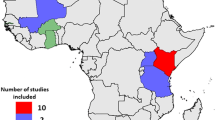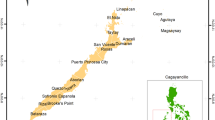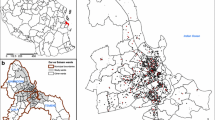Abstract
The risk of malaria infection displays spatial and temporal variability that is likely due to interaction between the physical environment and the human population. In this study, we performed a spatial analysis at three different time points, corresponding to three cross-sectional surveys conducted as part of an insecticide-treated bed nets efficacy study, to reveal patterns of malaria incidence distribution in an area of Northern Guatemala characterized by low malaria endemicity. A thorough understanding of the spatial and temporal patterns of malaria distribution is essential for targeted malaria control programs. Two methods, the local Moran’s I and the Getis-Ord G*(d), were used for the analysis, providing two different statistical approaches and allowing for a comparison of results. A distance band of 3.5 km was considered to be the most appropriate distance for the analysis of data based on epidemiological and entomological factors. Incidence rates were higher at the first cross-sectional survey conducted prior to the intervention compared to the following two surveys. Clusters or hot spots of malaria incidence exhibited high spatial and temporal variations. Findings from the two statistics were similar, though the G*(d) detected cold spots using a higher distance band (5.5 km). The high spatial and temporal variability in the distribution of clusters of high malaria incidence seems to be consistent with an area of unstable malaria transmission. In such a context, a strong surveillance system and the use of spatial analysis may be crucial for targeted malaria control activities.











Similar content being viewed by others

References
Abeku TA, van Oortmarssen GJ, Borsboom G, de Vlas SJ, Habbema J (2003) Spatial and temporal variations of malaria epidemic risk in Ethiopia: factors involved and implications. Acta Trop 87(3):331–340. https://doi.org/10.1016/S0001-706X(03)00123-2
Achee NL, Grieco JP, Andre RG, Rejmankova E, Roberts DR (2007) A mark-release-recapture study to define the flight behaviorsof Anopheles vestitipennis and Anopheles albimanus in Belize, Central America. J Amer Mosq Control Assoc 23(3):276–282. https://doi.org/10.2987/8756-971X(2007)23[276:AMSTDT]2.0.CO;2
Anselin L (1995) Local indicators of spatial association—LISA. Geogr Anal 27(2):93–115. https://doi.org/10.1111/j.1538-4632.1995.tb00338.x
Bejon P, Williams TN, Liljander A, Noor AM, Wambua J, Ogada E, Olotu A, Osier FHA, Hay S, Färnert A, Marsh K (2010) Stable and unstable malaria hotspots in longitudinal cohort studies in Kenya. PLoS Med 7(7):915. https://doi.org/10.1371/journal.pmed.1000304
Bødker R, Akida J, Shayo D, Kisinza W, Msangeni H, Pedersen E, Lindsay S (2003) Relationship between altitude and intensity of malaria transmission in the Usambara Mountains, Tanzania. J Med Entomol 40(5):706–717. https://doi.org/10.1603/0022-2585-40.5.706
Bousema T, Drakeley C, Gesase S, Hashim R, Magesa S, Mosha F, Otieno S, Carneiro I, Cox J, Msuya E, Kleinschmidt I, Maxwell C, Greenwood B, Riley E, Sauerwein R, Chandramohan D, Gosling R (2010) Identification of hot spots of malaria transmission for targeted malaria control. J Infect Dis 201(11):1764–1774. https://doi.org/10.1086/652456
Caldas de Castro M, Singer BH (2006) Controlling the false discovery rate: a new application to account for multiple and dependent tests in local statistics of spatial association. Geogr Anal 38(2):180–208. https://doi.org/10.1111/j.0016-7363.2006.00682.x
Caldas de Castro M, Sawyer DO, Singer BH (2007) Spatial patterns of malaria in the Amazon: implications for surveillance and targeted interventions. Health Place 13(2):368–380. https://doi.org/10.1016/j.healthplace.2006.03.006
Carter R, Mendis KN, Roberts D (2000) Spatial targeting of interventions against malaria. Bull World Health Organ 78(12):1401–1411
Consejo Municipal de Desarrollo del Municipio de Ixcan, Quiche y Secretaria de Planificacion y Programacion de la Presidencia (2010) Plan de desarrollo Ixcan, Quiche. http://www.google.com/url?sa=t&rct=j&q=&esrc=s&source=web&cd=1&ved=0ahUKEwie2Y-2pd_bAhUEZ1AKHRPyBhUQFggnMAA&url=http%3A%2F%2Fwww.segeplan.gob.gt%2Fnportal%2Findex.php2Fbibliotecadocumental%2Fcategory%2F62-quiche%3Fdownload%3D278%3Apdm-playa-grandeixcan&usg=AOvVaw3lQBXOsuYMvLAh3Qx9iI21. Accessed 22 August 2015
Doolan DL, Dobano C, Baird JK (2009) Acquired immunity to malaria. Clin Microbiol Rev 22(1):13–36, Table of contents. https://doi.org/10.1128/CMR.00025-08
Esri (2012) Modeling spatial relationships. http://resources.arcgis.com/en/help/main/10.1/index.html#/Modeling_spatial_relationships/005p00000005000000/GUID-729B3B01-6911-41E9-AA99-8A4CF74EEE27/. Accessed 26 August 2015
Fisher H (1923) Report of the health department of the Panama Canal for 1922. Report of the Health Department of the Panama Canal for 1922. Mount Hope
Gething PW, Van Boeckel TP, Smith DL, Guerra CA, Patil AP, Snow RW, Hay SI (2011) Modelling the global constraints of temperature on transmission of Plasmodium falciparum and P. vivax. Parasite Vector 4(92):4. https://doi.org/10.1186/1756-3305-4-92
Getis A, Ord JK (1992) The analysis of spatial association by use of distance statistics. Geogr Anal 24(3):189–206. https://doi.org/10.1111/j.1538-4632.1992.tb00261.x
Getis A, Ord J (1996) Spatial analysis and modeling in a GIS environment. A research agenda for geographic information science, pp. 157–196
Grillet ME, Barrera R, Martinez JE, Berti J, Fortin MJ (2010) Disentangling the effect of local and global spatial variation on a mosquito-borne infection in a neotropical heterogeneous environment. Am J Trop Med Hyg 82(2):194–201. https://doi.org/10.4269/ajtmh.2010.09-0040
Guthmann J, Llanos Cuentas A, Palacios A, Hall A (2002) Environmental factors as determinants of malaria risk. A descriptive study on the northern coast of Peru. Tropical Med Int Health 7(6):518–525. https://doi.org/10.1046/j.1365-3156.2002.00883.x
Hakre S, Masuoka P, Vanzie E, Roberts DR (2004) Spatial correlations of mapped malaria rates with environmental factors in Belize, Central America. Int J Health Geogr 3(1):6. https://doi.org/10.1186/1476-072X-3-6
Hui FM, Xu B, Chen ZW, Cheng X, Liang L, Huang HB, Fang LQ, Yang H, Zhou HN, Yang HL, Zhou XN, Cao WC, Gong P (2009) Spatio-temporal distribution of malaria in Yunnan province, China. Am J Trop Med Hyg 81(3):503–509. https://doi.org/10.4269/ajtmh.2009.81.503
Instituto Nacional de Electrificacion (2014) Hidroeléctrica Chixoy se presenta como caso de éxito en hidroindustria. http://www.inde.gob.gt/. Accessed 2 September 2015
Instituto Nacional de Sismologia, Vulcanologia, Meteorologia e Hidrologia (2013) Estaciones meteorologicas en Guatemala. http://www.insivumeh.gob.gt/meteorologia/mapa_estaciones2.htm. Accessed 2 September 2015
Jacquez GM (2008) Spatial cluster analysis. In: The Handbook of Geographic Information Science. Blackwell, Malden, pp 395–416
Kitron U (1998) Landscape ecology and epidemiology of vector-borne diseases: tools for spatial analysis. J Med Entomol 35(4):435–445. https://doi.org/10.1093/jmedent/35.4.435
Lennon ME, Miranda A, Henao J, Vallejo AF, Perez J, Alvarez A, Arévalo-Herrera M, Herrera S (2016) Malaria elimination challenges in Mesoamerica: evidence of submicroscopic malaria reservoirs in Guatemala. Malar J 15(1):441. https://doi.org/10.1186/s12936-016-1500-6
Lindsay SW, Martens WJ (1998) Malaria in the African Highlands: past, present and future. Bull World Health Organ 76(1):33–45
Lu C, Chen D, Kou Y (2003) Algorithms for spatial outlier detection. Data Mining, 2003. ICDM 2003. Third IEEE International Conference on Data Mining, 597–600. doi https://doi.org/10.1109/icdm.2003.1250986
Malvisi L (2015) The impact of insecticide-treated bed nets on malaria incidence in Ixcan, Guatemala and the associated identification of spatial clusters of malaria. Texas Medical Center Dissertations (via ProQuest). AAI10027729. http://digitalcommons.library.tmc.edu/dissertations/AAI10027729
Mantilla G, Oliveros H, Barnston AG (2009) The role of ENSO in understanding changes in Colombia’s annual malaria burden by region, 1960–2006. Malar J 8(6):1–11. https://doi.org/10.1186/1475-2875-8-6
Maxwell CA, Chambo W, Mwaimu M, Magogo F, Carneiro IA, Curtis CF (2003) Variation of malaria transmission and morbidity with altitude in Tanzania and with introduction of alphacypermethrin treated nets. Malar J 2:28. https://doi.org/10.1186/1475-2875-2-28
Medina CE, Gomez-Enri J, Alonso JJ, Villares P (2008) Water level fluctuations derived from ENVISAT radar altimeter (RA-2) and in-situ measurements in a subtropical waterbody: Lake Izabal (Guatemala). Remote Sens Environ 112(9):3604–3617. https://doi.org/10.1016/j.rse.2008.05.001
Minakawa N, Sonye G, Mogi M, Githeko A, Yan G (2002) The effects of climatic factors on the distribution and abundance of malaria vectors in Kenya. J Med Entomol 39(6):833–841. https://doi.org/10.1603/0022-2585-39.6.833
Narciso R, Estrada D, Escobar P, Reyes M (2013) Caracterizacion departamental—Quiche 2012. Guatemala City, Guatemala: Instituto Nacional de Estadistica. https://www.ine.gob.gt/sistema/uploads/2013/12/09/AwfjjE8PjNlI3D4DnpYnoGmtL7oux9xH.pdf. Accessed 26 August 2015
Ord JK, Getis A (1995) Local spatial autocorrelation statistics: distributional issues and an application. Geogr Anal 27(4):286–306. https://doi.org/10.1111/j.1538-4632.1995.tb00912.x
Ostfeld RS, Glass GE, Keesing F (2005) Spatial epidemiology: an emerging (or re-emerging) discipline. Trends Ecol Evol 20(6):328–336. https://doi.org/10.1016/j.tree.2005.03.009
Paaijmans KP, Read AF, Thomas MB (2009) Understanding the link between malaria risk and climate. Proc Natl Acad Sci U S A 106(33):13844–13849. https://doi.org/10.1073/pnas.0903423106
Paaijmans KP, Blanford S, Bell AS, Blanford JI, Read AF, Thomas MB (2010) Influence of climate on malaria transmission depends on daily temperature variation. Proc Natl Acad Sci U S A 107(34):15135–15139. https://doi.org/10.1073/pnas.1006422107
Patz JA, Olson SH (2006) Malaria risk and temperature: influences from global climate change and local land use practices. Proc Natl Acad Sci U S A 103(15):5635–5636. https://doi.org/10.1073/pnas.0601493103
Prothero RM (1995) Malaria in Latin America: environmental and human factors. Bull Latin Am Res 14(3):357–365
Rolfes MA, McCarra M, Magak NG, Ernst KC, Dent AE, Lindblade KA, John CC (2012) Development of clinical immunity to malaria in highland areas of low and unstable transmission. Am J Trop Med Hyg 87(5):806–812. https://doi.org/10.4269/ajtmh.2012.11-0530
Verdonschot PFM, Besse-Lototskaya AA (2014) Flight distance of mosquitoes (Culicidae): a metadata analysis to support the management of barrier zones around rewetted and newly constructed wetlands. Limnologica 45:69–79. https://doi.org/10.1016/j.limno.2013.11.002
World Health Organization (2017) World malaria report 2017. World Health Organization, Geneva
Xia J, Cai S, Zhang H, Lin W, Fan Y, Qiu J, Sun L, Chang B, Zhang Z, Nie S (2015) Spatial, temporal, and spatiotemporal analysis of malaria in Hubei Province, China from 2004–2011. Malaria J 14(1):145. https://doi.org/10.1186/s12936-015-0650-2
Yeshiwondim A, Gopal S, Hailemariam A, Dengela D, Patel H (2009) Spatial analysis of malaria incidence at the village level in areas with unstable transmission in Ethiopia. Int J Health Geogr 8(1):5. https://doi.org/10.1186/1476-072X-8-5
Acknowledgments
I wish to thank the Universidad del Valle de Guatemala (UVG) and the Center for Disease Control and Prevention (CDC) for allowing me to use their data. I wish to thank Dr. Norma Padilla, director of the parasitic disease program at UVG, and her research team for their expertise in malaria control and entomology.
Author information
Authors and Affiliations
Corresponding author
Ethics declarations
Conflict of interest
The authors declare that they have no conflicts of interest.
Ethical approval
The study was approved by the Ethics Committee of the Universidad del Valle de Guatemala on July 3, 2000 and the permission to analyze the data was granted by the Ethics Committee of the University of Texas Health Science Center at Houston on August 14, 2015 (permit code HSC-SPH-15-0551). All procedures performed in studies involving human participants were in accordance with the ethical standards of the institutional and/or national research committee and with the 1964 Helsinki declaration and its later amendments or comparable ethical standards.
Informed consent
Informed consent was obtained from all individual participants included in the study.
Rights and permissions
About this article
Cite this article
Malvisi, L., Troisi, C.L. & Selwyn, B.J. Analysis of the spatial and temporal distribution of malaria in an area of Northern Guatemala with seasonal malaria transmission. Parasitol Res 117, 2807–2822 (2018). https://doi.org/10.1007/s00436-018-5968-6
Received:
Accepted:
Published:
Issue Date:
DOI: https://doi.org/10.1007/s00436-018-5968-6



